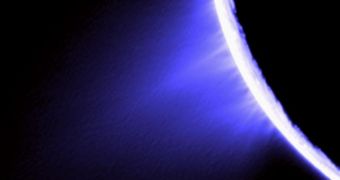Experts managing the NASA Cassini spacecraft believe that instruments aboard the orbiter may have identified a state of matter known as dusty plasma in the plumes of water-ice and organic molecules released by geysers on the icy Saturnine moon Enceladus.
These geysers are located inside landscape features called tiger stripes at the moon's south pole. The area is basically what makes this celestial body one of the most interesting objects in the solar system.
Plasma is hot ionized gas, and represents a very interesting state of matter. Though they knew that analyzing alien geysers might reveal new data on already established phenomena, experts at the NASA Jet Propulsion Laboratory (JPL) were not expecting to find this state of matter in the plumes.
Dusty plasma is a condition that was theorized to exist some time ago, but for which no evidence has thus far been produced. Normal plasma features two species of charged particles, heavy and light, but these are inversed from their normal disposition in the geyser plumes.
Details of the Cassini study appear in two research papers published in the esteemed scientific Journal of Geophysical Research. “These are truly exciting discoveries for plasma science,” expert Tamas Gombosi explains.
“Cassini is providing us with a new plasma physics laboratory.” adds the researcher, who holds an appointment as a Cassini fields and particles interdisciplinary scientist at the University of Michigan in Ann Arbor.
The spacecraft has been studying Saturn, its moons and its ring system since achieving orbital insertion around the gas giant, on July 1, 2004. During dozens of flybys of Enceladus, it managed to determine that the moon's geysers also contribute mass to the planet's E Ring.
Dusty plasma differs from dust in plasma through the behavior that negative and positive ions display. In the former, the dust is electrically charged and becomes an integrated part of the plasma, primarily because of the strong coupling it forms with ions.
“Such strong coupling indicates the possible presence of so-called 'dusty plasma', rather than the 'dust in a plasma' conditions which are common in interplanetary space,” Swedish Institute of Space Physics expert Michiko Morooka explains.
“Except for measurements in Earth's upper atmosphere, there have previously been no in-situ observations of dusty plasma in space,” concludes the expert, who is a Cassini radio and plasma wave science co-investigator, and the lead author of one of the papers.

 14 DAY TRIAL //
14 DAY TRIAL //